状语从句引导词的含义大全
状语从句的引导词及用法

状语从句的引导词及用法状语从句是复合句的一种,它用来修饰主句中的动词、形容词、副词或整个句子,起到表示时间、条件、原因、目的、结果等关系的作用。
在状语从句中,引导词起到连接主句和从句的作用,不同的引导词对应不同的语法功能。
本文将介绍常见的状语从句引导词及其用法。
1. 时间状语从句时间状语从句用来表示动作或状态发生的时间。
常见的引导词有:when(当...的时候)、while(当...的时候)、before(在...之前)、after(在...之后)、since(自从...以来)等。
例句:- I will call you when I arrive in Beijing.(当我到达北京时,我会给你打电话。
)- While I was studying, my sister was watching TV.(当我正在学习时,我妹妹在看电视。
)- Before I go to bed, I always brush my teeth.(睡觉前,我总是刷牙。
)- After I finished my homework, I went to play basketball.(在我完成作业之后,我去打篮球了。
)- Since she moved to New York, she has made many friends.(自从她搬到纽约以来,她交到了很多朋友。
)2. 条件状语从句条件状语从句用来表示动作发生的条件。
常见的引导词有:if(如果)、unless(除非)、provided that(只要)、as long as(只要)、in case(万一)等。
例句:- If it rains tomorrow, we will stay at home.(如果明天下雨,我们会待在家里。
)- I will go to the party unless I am busy.(我会去参加派对,除非我很忙。
)- You can go out, provided that you finish your homework.(只要你完成作业,你可以出去。
状语从句的引导词及用法详解
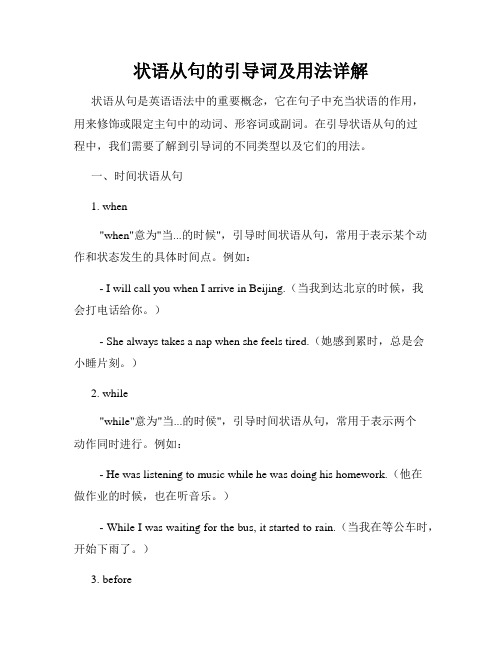
状语从句的引导词及用法详解状语从句是英语语法中的重要概念,它在句子中充当状语的作用,用来修饰或限定主句中的动词、形容词或副词。
在引导状语从句的过程中,我们需要了解到引导词的不同类型以及它们的用法。
一、时间状语从句1. when"when"意为"当...的时候",引导时间状语从句,常用于表示某个动作和状态发生的具体时间点。
例如:- I will call you when I arrive in Beijing.(当我到达北京的时候,我会打电话给你。
)- She always takes a nap when she feels tired.(她感到累时,总是会小睡片刻。
)2. while"while"意为"当...的时候",引导时间状语从句,常用于表示两个动作同时进行。
例如:- He was listening to music while he was doing his homework.(他在做作业的时候,也在听音乐。
)- While I was waiting for the bus, it started to rain.(当我在等公车时,开始下雨了。
)3. before"before"意为"在...之前",引导时间状语从句,常用于表示在某个动作之前发生的动作。
例如:- Please finish your homework before you go out to play.(在你出去玩之前,请完成你的作业。
)- Susan had already left the office before I arrived.(在我到达之前,苏珊已经离开了办公室。
)二、原因状语从句1. because"because"意为"因为",引导原因状语从句,常用于表示某个动作或状态发生的原因。
状语从句的引导词及其区别

状语从句的引导词及其区别状语从句在句中作状语,修饰主句中的动词、形容词和副词等。
按其作用和意义可分为时间、原因、目的、结果、条件、让步、方式、比较,地点九种。
下面对这九种从句的要点加以总结。
一、各类状语从句的引导词及易混词的区别。
1. 时间状语从句1) 引导词(1)表示“当……时候”:when, while, as, wheneverWhen I went into the room, he was at work. 当我进屋时,他在工作。
While it was raining, they went out. 正在下着雨时,他们出去了。
Whenever he comes, he brings a friend. 他每次来都带个朋友。
(2)表示“一……就……”:as soon as, the moment/minute/instant, immediately/directly/instantly , hardly/scarcely…when, no sooner…than I’ll tell you the news the moment you come.你一来我就告诉你那个消息。
The machine will start instantly you press the button. 你一按按钮机器就会开动。
Hardly/Scarcely had I got to the cinema when the film began. 我一到电影院,电影就开始了。
I had no sooner reached home than it began to rain.我一到家天就下起了雨。
(3)其它:after, before, since, until, by the time,each time, next timeThe boy went to bed after he finished my homework. 那男孩做完家庭作业之后才睡觉。
状语从句的引导词

状语从句的引导词状语从句是句子中用来修饰动词、形容词、副词等状语的从句。
而状语从句的引导词在句子中起着连接主句与从句的作用,帮助句子表达更准确、更流畅的含义。
本文将介绍状语从句的引导词,并针对不同引导词进行讲解。
1. 时间状语从句时间状语从句用来表示动作发生的具体时间,常由when, while, before, after, since, until, as soon as等引导。
例如:- When I arrived at the office, my colleagues were already there.- He watches TV while he is eating dinner.- Before they left, they finished all their homework.2. 地点状语从句地点状语从句用来表示行为发生的地点,常由where, wherever引导。
例如:- I will go wherever you go.- I will meet you where we first met.3. 原因状语从句原因状语从句用来表示动作的原因或理由,常由because, since, as,for等引导。
例如:- He was late for work because his car broke down.- Since it is raining, we will stay inside.- I will study hard as I want to pass the exam.4. 目的状语从句目的状语从句用来表示动作的目的,常由in order that, so that引导。
例如:- I study hard so that I can get good grades.- I will buy some groceries in order that we can cook dinner.5. 结果状语从句结果状语从句用来表示一个动作的结果,常由so that, so...that, such...that, such...as等引导。
状语从句的引导词与用法
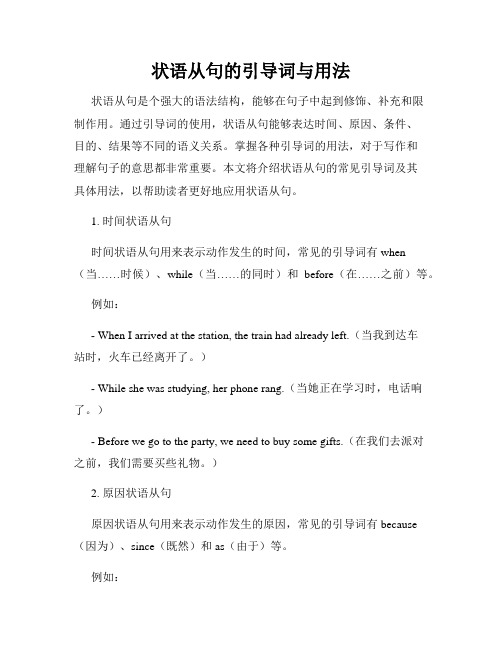
状语从句的引导词与用法状语从句是个强大的语法结构,能够在句子中起到修饰、补充和限制作用。
通过引导词的使用,状语从句能够表达时间、原因、条件、目的、结果等不同的语义关系。
掌握各种引导词的用法,对于写作和理解句子的意思都非常重要。
本文将介绍状语从句的常见引导词及其具体用法,以帮助读者更好地应用状语从句。
1. 时间状语从句时间状语从句用来表示动作发生的时间,常见的引导词有when (当……时候)、while(当……的同时)和before(在……之前)等。
例如:- When I arrived at the station, the train had already left.(当我到达车站时,火车已经离开了。
)- While she was studying, her phone rang.(当她正在学习时,电话响了。
)- Before we go to the party, we need to buy some gifts.(在我们去派对之前,我们需要买些礼物。
)2. 原因状语从句原因状语从句用来表示动作发生的原因,常见的引导词有because (因为)、since(既然)和as(由于)等。
例如:- I couldn't go to the party because I had to work.(我不能去参加派对,因为我得工作。
)- Since it's raining, we should take an umbrella.(既然下雨了,我们应该带把伞。
)- As he was tired, he decided to go to bed early.(由于他累了,他决定早点上床睡觉。
)3. 条件状语从句条件状语从句用来表示动作发生的条件,常见的引导词有if(如果)、unless(除非)和when(当……时候)等。
例如:- If it rains tomorrow, we will stay at home.(如果明天下雨,我们会呆在家里。
状语从句的引导词及使用方法

状语从句的引导词及使用方法状语从句是语法中常用的从句类型之一,用于修饰主句中的动词、形容词或副词,并提供更加详细的信息。
在状语从句中,引导词起到连接主句和从句的作用。
为了正确使用状语从句,我们需要熟悉各种引导词以及它们的用法。
本文将介绍状语从句的常见引导词以及它们的使用方法。
1. 时间状语从句(Time clauses)时间状语从句用于描述主句中的动作发生的时间。
以下是一些常见的时间状语从句引导词:当(when):表示主句和从句的动作发生时间是同时的。
例句:当我看到她的时候,她正在读书。
一…就(as soon as):表示从句动作在主句动作发生之后立即发生。
例句:我一到家,就开始做作业。
每当(whenever):表示主句的动作发生,从句的动作总是重复发生。
例句:每当我看到这幅画,我就想起了童年的回忆。
2. 地点状语从句(Place clauses)地点状语从句用于修饰主句中的地点信息。
以下是一些常见的地点状语从句引导词:哪里(where):表示主句和从句的地点相同。
例句:我住在哪里距离公司很近。
无论…在哪里(wherever):表示不管主句的地点如何变化,从句的地点总是相同的。
例句:无论我走到哪里,我都会想念家乡。
3. 原因状语从句(Reason clauses)原因状语从句用于解释主句中的原因。
以下是一些常见的原因状语从句引导词:因为(because):表示从句中的原因是主句中动作发生的原因。
例句:我喜欢旅行,因为我喜欢探索新的文化。
由于(due to):表示主句中的原因造成了从句的结果。
例句:由于天气恶劣,比赛被取消了。
4. 条件状语从句(Condition clauses)条件状语从句用于描述达成某种条件时的结果。
以下是一些常见的条件状语从句引导词:如果(if):表示某个条件为真时,从句的结果会发生。
例句:如果你努力学习,你就会取得好成绩。
除非(unless):表示除非某个条件不成立,否则从句的结果会发生。
状语从句的引导词及作用

状语从句的引导词及作用状语从句是指在句子中充当状语的从句。
它通常由引导词引导,用来修饰或限定主句中的动作、状态或属性。
状语从句可以分为时间状语从句、地点状语从句、方式状语从句、原因状语从句、条件状语从句等等。
在各类状语从句中,不同的引导词有着不同的作用,本文将就状语从句的引导词及其作用进行探讨。
1. 时间状语从句时间状语从句用来表示一个动作发生的时间。
常见的时间状语从句的引导词有when(当...时候)、while(当...时)、before(在...之前)、after(在...之后)、since(自从)等。
例如:- When I arrived at the airport, the flight had already taken off.当我到达机场的时候,飞机已经起飞了。
- While I was watching TV, the phone suddenly rang.当我正在看电视的时候,电话突然响了。
- Before she went to bed, she double-checked all the doors and windows.在她上床睡觉之前,她仔细检查了所有的门窗。
- After he finished his homework, he went out to play.在他完成作业之后,他出去玩了。
- Since I started learning English, my communication skills have improved significantly.自从我开始学习英语以来,我的沟通能力显著提高了。
2. 地点状语从句地点状语从句用来表示一个动作发生的地点。
常见的地点状语从句的引导词有where(在哪里)、wherever(无论在哪里)。
例如:- We will meet in the park where we often go for a walk.我们将会在我们经常散步的公园见面。
状语从句的引导词和用法
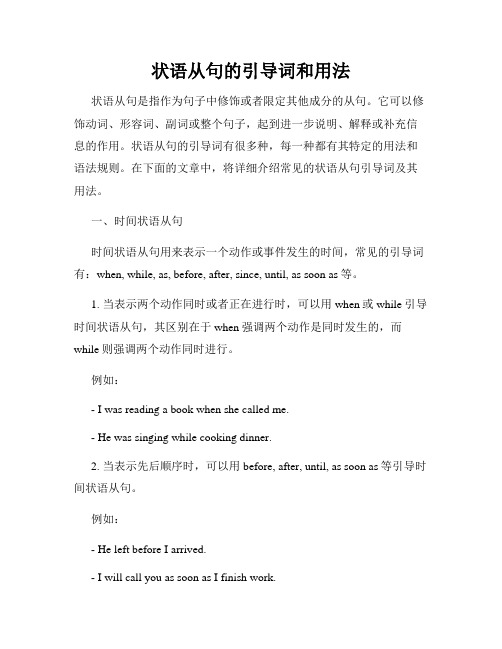
状语从句的引导词和用法状语从句是指作为句子中修饰或者限定其他成分的从句。
它可以修饰动词、形容词、副词或整个句子,起到进一步说明、解释或补充信息的作用。
状语从句的引导词有很多种,每一种都有其特定的用法和语法规则。
在下面的文章中,将详细介绍常见的状语从句引导词及其用法。
一、时间状语从句时间状语从句用来表示一个动作或事件发生的时间,常见的引导词有:when, while, as, before, after, since, until, as soon as等。
1. 当表示两个动作同时或者正在进行时,可以用when或while引导时间状语从句,其区别在于when强调两个动作是同时发生的,而while则强调两个动作同时进行。
例如:- I was reading a book when she called me.- He was singing while cooking dinner.2. 当表示先后顺序时,可以用before, after, until, as soon as等引导时间状语从句。
例如:- He left before I arrived.- I will call you as soon as I finish work.二、地点状语从句地点状语从句用来表示一个动作或事件发生的地点,常见的引导词有:where, wherever等。
例如:- I will meet you where we first met.三、方式状语从句方式状语从句用来表示一个动作或事件的方式或者方法,常见的引导词有:as, as if, as though等。
例如:- She danced as if nobody was watching.四、原因状语从句原因状语从句用来表示一个动作或事件的原因,常见的引导词有:because, since, as, owing to, due to等。
例如:- I couldn't come to the party because I was sick.五、目的状语从句目的状语从句用来表示一个动作或事件的目的,常见的引导词有:so that, in order that等。
状语从句的引导词总结
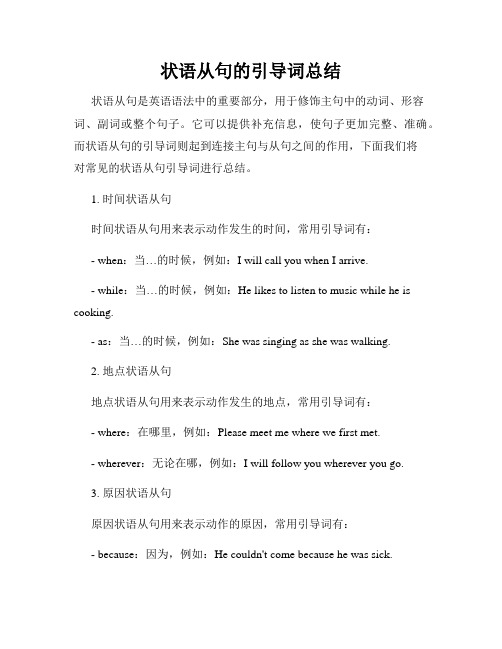
状语从句的引导词总结状语从句是英语语法中的重要部分,用于修饰主句中的动词、形容词、副词或整个句子。
它可以提供补充信息,使句子更加完整、准确。
而状语从句的引导词则起到连接主句与从句之间的作用,下面我们将对常见的状语从句引导词进行总结。
1. 时间状语从句时间状语从句用来表示动作发生的时间,常用引导词有:- when:当…的时候,例如:I will call you when I arrive.- while:当…的时候,例如:He likes to listen to music while he is cooking.- as:当…的时候,例如:She was singing as she was walking.2. 地点状语从句地点状语从句用来表示动作发生的地点,常用引导词有:- where:在哪里,例如:Please meet me where we first met.- wherever:无论在哪,例如:I will follow you wherever you go.3. 原因状语从句原因状语从句用来表示动作的原因,常用引导词有:- because:因为,例如:He couldn't come because he was sick.- since:既然,由于,例如:Since you are not interested, we won't force you.- as:由于,例如:As I was tired, I went to bed early.4. 条件状语从句条件状语从句用来表示动作发生的条件,常用引导词有:- if:如果,例如:If it rains tomorrow, we will stay at home.- unless:除非,如果不,例如:I won't go unless you come with me.- provided that:倘若,只要,例如:You can borrow my car provided that you return it tomorrow.5. 方式状语从句方式状语从句用来表示动作的方式,常用引导词有:- as if/though:好像,仿佛,例如:He looked at me as if he had seen a ghost.- like:像…那样,例如:She sang like an angel.6. 结果状语从句结果状语从句用来表示动作的结果,常用引导词有:- so that:以便,所以,例如:He studied hard so that he could pass the exam.- such that:如此…以至于,例如:She was so tired that she fell asleep immediately.7. 让步状语从句让步状语从句用来表示与主句所陈述的事实相反的条件,常用引导词有:- although:尽管,虽然,例如:Although it was raining, they still went out.- even though:即使,尽管,例如:Even though it was late, they continued to work.总结:状语从句的引导词有很多种,需要根据句子的意思与语境来选择适当的引导词。
英语语法 条件状语从句的引导词有哪些

英语语法条件状语从句的引导词有哪些条件状语从句的引导词用于引导条件状语从句,表达某种条件下发生或不发生某个动作或情况。
以下是常见的条件状语从句引导词及其用法的详细解释:1. "if":意为"如果"。
它是最常用的条件状语从句引导词。
例如:- If it rains tomorrow, we will stay at home.(如果明天下雨,我们会呆在家里。
)- I will be happy if I pass the exam.(如果我通过考试,我会很开心。
)2. "unless":意为"除非"。
它表示只有在某个条件不满足时才会发生某个动作或情况。
例如:- I won't go to the party unless you come with me.(除非你和我一起去,否则我不会去参加聚会。
)- She won't eat dessert unless it's chocolate.(除非是巧克力,否则她不吃甜点。
)3. "provided that"和"providing (that)":意为"只要"。
它们表示只要满足某个条件,就会发生某个动作或情况。
例如:- You can borrow my car provided that you return it by tomorrow.(只要你明天之前归还,你可以借我的车。
)- You can have the job, provided that you have the necessary qualifications.(只要你具备必要的资格,你可以得到这份工作。
)4. "as long as":意为"只要"。
它表示只要某个条件一直得到满足,就会持续发生某个动作或情况。
状语从句的引导词和作用

状语从句的引导词和作用状语从句是复合句的一种结构,用来修饰或限制主句中的动作、状态或属性。
它起到了连接主句和从句的作用,使整个句子更加丰富多样。
在状语从句中,引导词起到了引导作用,不同的引导词在语法功能上有所区别。
本文将介绍常见的状语从句引导词以及它们在句子中的作用。
一、因果状语从句引导词因果状语从句用来表示主句和从句之间的因果关系。
常见的引导词有"因为"、"由于"、"所以"、"以致"等。
例如:1. 由于天气炎热,他决定去游泳。
2. 他学习非常努力,所以考了个好成绩。
二、条件状语从句引导词条件状语从句用来表示主句和从句之间的条件关系。
常见的引导词有"如果"、"只要"、"除非"、"假如"等。
例如:1. 如果你不努力学习,就无法取得好成绩。
2. 只要你有足够的耐心,这个问题就能解决。
三、时间状语从句引导词有"当"、"一直到"、"每当"、"直到"等。
例如:1. 当他来的时候,我们已经吃完饭了。
2. 每当我听到这首歌,就会想起那个夏天。
四、地点状语从句引导词地点状语从句用来表示主句和从句之间的地点关系。
常见的引导词有"哪里"、"哪儿"、"所在"等。
例如:1. 我们去了国外,感受了不同的文化。
2. 我们不知道他去了哪里。
五、方式状语从句引导词方式状语从句用来表示主句和从句之间的方式关系。
常见的引导词有"怎样"、"如何"、"以"等。
例如:1. 她告诉我们学好英语的方法是多读多练习。
2. 以他的能力,一定能完成这个任务。
六、目的状语从句引导词有"为了"、"以便"、"以免"、"用来"等。
状语从句引导词解析考研状语从句引导词的用法

状语从句引导词解析考研状语从句引导词的用法状语从句引导词解析——考研状语从句引导词的用法状语从句是英语中常见的一种从句结构,用于修饰谓语动词或整个句子的成分。
它可以表达时间、原因、条件、目的、方式、地点等各种不同的状况或情境。
在考研英语中,掌握状语从句的用法是非常重要的,下面将对考研常见的状语从句引导词进行解析。
一、时间状语从句引导词1. When:当...的时候(表示某个具体时刻或情况)例如:I will call you when I arrive home.(我到家的时候会给你打电话。
)2. Before:在...之前(表示在主句之前发生的动作)例如:Please finish your homework before you go out.(在你出去之前请先完成作业。
)3. After:在...之后(表示在主句之后发生的动作)例如:After I finished my work, I went to bed.(我完成工作后就上床睡觉了。
)4. While:当...的时候(表示两个动作同时进行)例如:While I was reading, my sister was watching TV.(我在看书的同时,我妹妹在看电视。
)二、原因状语从句引导词1. Because:因为(表示直接的原因)例如:I cannot go to the party because I am busy.(我因为忙不能去参加派对。
)2. Since:既然(表示看法或理由)例如:Since you don't like coffee, I will make you tea.(既然你不喜欢咖啡,那我给你泡茶。
)3. As:由于(表示原因或方式)例如:As it was raining heavily, we decided to stay at home.(由于下大雨,我们决定待在家里。
)三、条件状语从句引导词1. If:如果(表示假设或条件)例如:If it rains, we will stay at home.(如果下雨,我们会呆在家里。
什么是状语从句的引导词

什么是状语从句的引导词?状语从句(Adverbial Clause)是指在一个句子中充当状语的从句。
在状语从句中,需要使用一些特定的引导词来引导从句的开头。
以下是一些常用的状语从句引导词:1. 时间状语从句(Time Adverbial Clauses):- when:引导一个表示时间的状语从句,相当于“at the time”或“on the occasion”。
- I will call you when I arrive.(我到达时会给你打电话。
)- while:引导一个表示与主句同时进行的状语从句。
- While I was studying, my roommate was watching TV.(当我在学习时,室友在看电视。
)- before/after:引导一个表示在主句之前或之后发生的状语从句。
- She went to bed before I finished my work.(在我完成工作之前,她就上床睡觉了。
)- until/till:引导一个表示一直持续到某个时间点的状语从句。
- I will wait here until you come back.(我会在这里等你回来。
)2. 地点状语从句(Place Adverbial Clauses):- where:引导一个表示地点的状语从句。
- I will meet you where we agreed.(我会在我们约定的地方见你。
)3. 原因状语从句(Cause Adverbial Clauses):- because/since/as:引导一个表示原因的状语从句。
- He couldn't come because he was sick.(他因为生病所以不能来。
)- as a result/resulting in/so:引导一个表示结果的状语从句。
- He worked hard, so he passed the exam.(他努力学习,所以考试通过了。
状语从句的引导词及语法规则
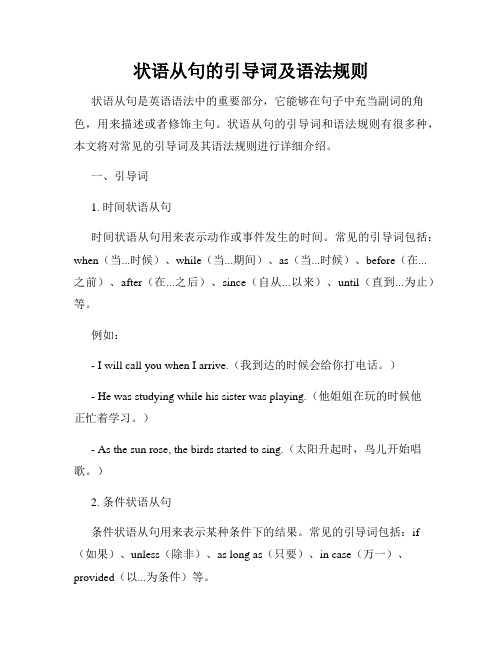
状语从句的引导词及语法规则状语从句是英语语法中的重要部分,它能够在句子中充当副词的角色,用来描述或者修饰主句。
状语从句的引导词和语法规则有很多种,本文将对常见的引导词及其语法规则进行详细介绍。
一、引导词1. 时间状语从句时间状语从句用来表示动作或事件发生的时间。
常见的引导词包括:when(当...时候)、while(当...期间)、as(当...时候)、before(在...之前)、after(在...之后)、since(自从...以来)、until(直到...为止)等。
例如:- I will call you when I arrive.(我到达的时候会给你打电话。
)- He was studying while his sister was playing.(他姐姐在玩的时候他正忙着学习。
)- As the sun rose, the birds started to sing.(太阳升起时,鸟儿开始唱歌。
)2. 条件状语从句条件状语从句用来表示某种条件下的结果。
常见的引导词包括:if (如果)、unless(除非)、as long as(只要)、in case(万一)、provided(以...为条件)等。
例如:- If it rains, we will stay at home.(如果下雨,我们就待在家里。
)- Unless you finish your homework, you cannot go out to play.(除非你完成作业,否则不能出去玩。
)- You can go swimming as long as you wear a life jacket.(只要你穿上救生衣,就可以去游泳。
)3. 原因状语从句原因状语从句用来表示某个行为或状态的原因。
常见的引导词包括:because(因为)、since(因为)、as(由于)、for(因为)、due to(由于)等。
例如:- He couldn't come to the party because he was sick.(他因为生病所以不能来参加派对。
状语从句的引导词和用法

状语从句的引导词和用法状语从句是英语语法中的一种从属从句类型,用来修饰主句中的动词、形容词、副词等,进一步对主句进行补充或说明。
在状语从句中,引导词起着连接主句和从句的作用。
不同的引导词可以引导不同类型的状语从句。
本文将介绍状语从句中常用的引导词及其用法。
一、时间状语从句时间状语从句用来表示一个动作或者状态发生的时间点或时间段。
以下是常见的引导词和用法:1. when:表示主句的动作和状语从句的动作同时发生。
例如:"Iwill call you when I arrive in London."(当我到达伦敦时,我会给你打电话。
)2. while:表示主句的动作和状语从句的动作同时进行。
例如:"He was reading a book while I was cooking dinner."(当我在做晚饭时,他在读书。
)3. before:表示主句的动作在状语从句的动作之前发生。
例如:"Please finish your homework before you go out."(在你出去之前,请完成你的作业。
)4. after:表示主句的动作在状语从句的动作之后发生。
例如:"Iwill go shopping after I have lunch."(我午饭后会去购物。
)二、地点状语从句地点状语从句用来表示一个动作或者状态发生的地点。
以下是常见的引导词和用法:1. where:表示主句的动作发生的地点。
例如:"Let's meet at thepark where we first met."(让我们在我们第一次见面的公园见面。
)2. wherever:表示主句的动作可以在任何地方进行。
例如:"Youcan sit wherever you like."(你可以坐在任何你喜欢的地方。
状语从句的引导词及用法
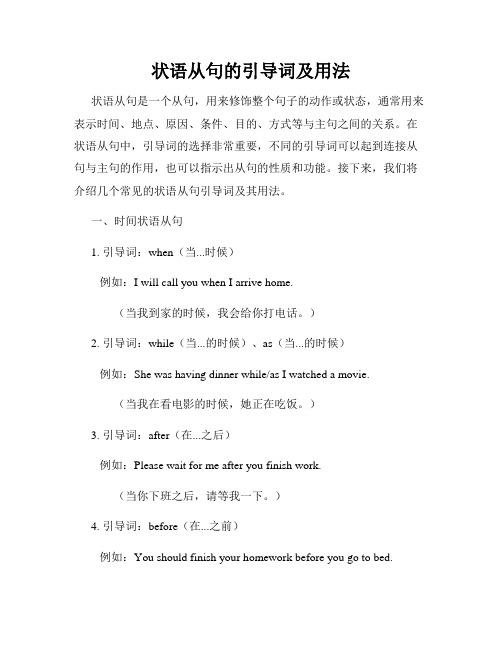
状语从句的引导词及用法状语从句是一个从句,用来修饰整个句子的动作或状态,通常用来表示时间、地点、原因、条件、目的、方式等与主句之间的关系。
在状语从句中,引导词的选择非常重要,不同的引导词可以起到连接从句与主句的作用,也可以指示出从句的性质和功能。
接下来,我们将介绍几个常见的状语从句引导词及其用法。
一、时间状语从句1. 引导词:when(当...时候)例如:I will call you when I arrive home.(当我到家的时候,我会给你打电话。
)2. 引导词:while(当...的时候)、as(当...的时候)例如:She was having dinner while/as I watched a movie.(当我在看电影的时候,她正在吃饭。
)3. 引导词:after(在...之后)例如:Please wait for me after you finish work.(当你下班之后,请等我一下。
)4. 引导词:before(在...之前)例如:You should finish your homework before you go to bed.(在你睡觉之前,你应该完成作业。
)二、地点状语从句1. 引导词:where(在哪里)例如:I still remember the place where we met for the first time.(我仍然记得我们第一次见面的地方。
)2. 引导词:wherever(无论在哪里)例如:You can find happiness wherever you go.(无论你去哪里,都能找到幸福。
)三、原因状语从句1. 引导词:because(因为)例如:I stayed at home because it was raining outside.(因为外面下雨,所以我呆在家里。
)2. 引导词:since(因为)例如:I haven't seen her since she moved to another city.(因为她搬到了别的城市,所以我没有见过她。
状语从句的引导词详解
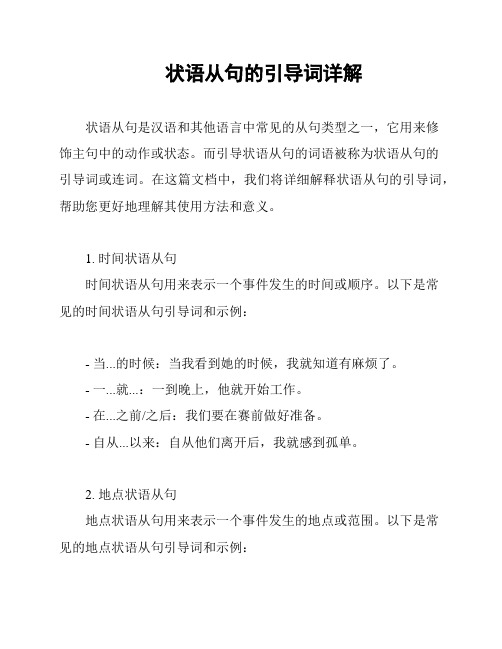
状语从句的引导词详解状语从句是汉语和其他语言中常见的从句类型之一,它用来修饰主句中的动作或状态。
而引导状语从句的词语被称为状语从句的引导词或连词。
在这篇文档中,我们将详细解释状语从句的引导词,帮助您更好地理解其使用方法和意义。
1. 时间状语从句时间状语从句用来表示一个事件发生的时间或顺序。
以下是常见的时间状语从句引导词和示例:- 当...的时候:当我看到她的时候,我就知道有麻烦了。
- 一...就...:一到晚上,他就开始工作。
- 在...之前/之后:我们要在赛前做好准备。
- 自从...以来:自从他们离开后,我就感到孤单。
2. 地点状语从句地点状语从句用来表示一个事件发生的地点或范围。
以下是常见的地点状语从句引导词和示例:- 在...的地方:你可以把行李放在那儿的地方。
- 在...之间:我们可以在两个城市之间选择一个中转点。
3. 原因状语从句原因状语从句用来表示一个事件发生的原因或理由。
以下是常见的原因状语从句引导词和示例:- 因为:因为下雨,所以比赛取消了。
- 既然:既然你已经来了,就请留下来吃晚餐吧。
4. 结果状语从句结果状语从句用来表示一个事件发生的结果或后果。
以下是常见的结果状语从句引导词和示例:- 所以:他很努力研究,所以取得了好成绩。
- 以致于:他忘记带钥匙,以致于无法进入房间。
5. 条件状语从句条件状语从句用来表示一个事件发生的条件或假设。
以下是常见的条件状语从句引导词和示例:- 如果:如果明天下雨,我们就取消外出计划。
- 除非:除非你累坏了,不然你不应该停下来休息。
6. 方式状语从句方式状语从句用来表示一个事件发生的方式或方式。
以下是常见的方式状语从句引导词和示例:- 如何:告诉我如何准备日常工作。
- 以便:她买了一个昂贵的笔记本以便更好地研究。
7. 比较状语从句比较状语从句用来表示一个事件和另一个事件进行比较。
以下是常见的比较状语从句引导词和示例:- 越...越...:她越练,她的弹琴技术就越好。
状语从句引导词的含义大全
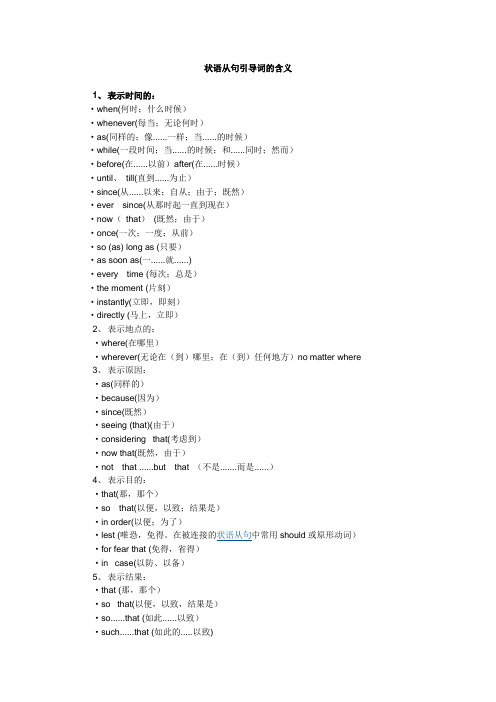
状语从句引导词的含义1、表示时间的:·when(何时;什么时候)·whenever(每当;无论何时)·as(同样的;像......一样;当......的时候)·while(一段时间;当......的时候;和......同时;然而)·before(在......以前)after(在......时候)·until、till(直到......为止)·since(从......以来;自从;由于;既然)·ever since(从那时起一直到现在)·now(that)(既然;由于)·once(一次;一度;从前)·so (as) long as (只要)·as soon as(一......就......)·every time (每次;总是)·the moment (片刻)·instantly(立即,即刻)·directly (马上,立即)2、表示地点的:·where(在哪里)·wherever(无论在(到)哪里;在(到)任何地方)no matter where 3、表示原因:·as(同样的)·because(因为)·since(既然)·seeing (that)(由于)·considering that(考虑到)·now that(既然,由于)·not that ......but that (不是.......而是......)4、表示目的:·that(那,那个)·so that(以便,以致;结果是)·in order(以便;为了)·lest (唯恐,免得。
在被连接的状语从句中常用should或原形动词)·for fear that (免得,省得)·in case(以防、以备)5、表示结果:·that (那,那个)·so that(以便,以致,结果是)·so......that (如此......以致)·such......that (如此的.....以致)6、表示条件的:·if (是否,如果)·unless(如果不,除非)·suppose(假设)·supposing(假设。
英语中的状语从句引导词
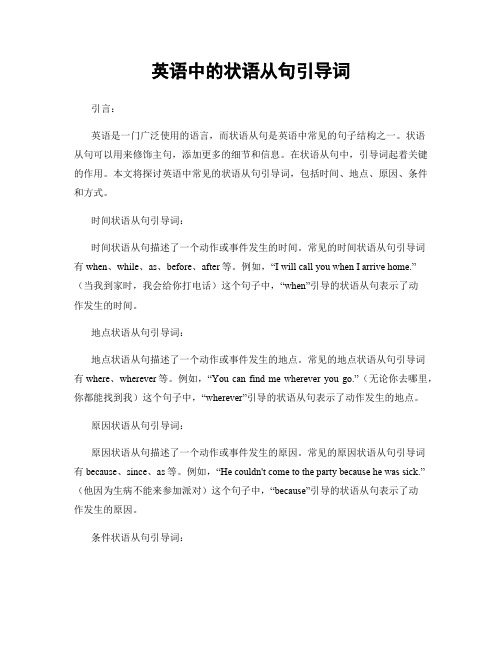
英语中的状语从句引导词引言:英语是一门广泛使用的语言,而状语从句是英语中常见的句子结构之一。
状语从句可以用来修饰主句,添加更多的细节和信息。
在状语从句中,引导词起着关键的作用。
本文将探讨英语中常见的状语从句引导词,包括时间、地点、原因、条件和方式。
时间状语从句引导词:时间状语从句描述了一个动作或事件发生的时间。
常见的时间状语从句引导词有when、while、as、before、after等。
例如,“I will call you when I arrive home.”(当我到家时,我会给你打电话)这个句子中,“when”引导的状语从句表示了动作发生的时间。
地点状语从句引导词:地点状语从句描述了一个动作或事件发生的地点。
常见的地点状语从句引导词有where、wherever等。
例如,“You can find me wherever you go.”(无论你去哪里,你都能找到我)这个句子中,“wherever”引导的状语从句表示了动作发生的地点。
原因状语从句引导词:原因状语从句描述了一个动作或事件发生的原因。
常见的原因状语从句引导词有because、since、as等。
例如,“He couldn't come to the party because he was sick.”(他因为生病不能来参加派对)这个句子中,“because”引导的状语从句表示了动作发生的原因。
条件状语从句引导词:条件状语从句描述了一个动作或事件发生的条件。
常见的条件状语从句引导词有if、unless、provided that等。
例如,“I will go hiking tomorrow if the weather is nice.”(如果天气好的话,我明天会去远足)这个句子中,“if”引导的状语从句表示了动作发生的条件。
方式状语从句引导词:方式状语从句描述了一个动作或事件发生的方式。
常见的方式状语从句引导词有as、like、the way等。
九种状语从句的引导词及例句-概述说明以及解释

九种状语从句的引导词及例句-概述说明以及解释1.引言文章1.1 概述部分的内容可以如下所示:引言是文章的开头部分,用来引出文章的主题和目的。
在本文中,我们将探讨九种状语从句的引导词及其例句。
状语从句是句子中的一个从句,用来修饰或补充主句的意思,起到说明、解释、强调等作用。
通过学习和掌握这九种状语从句的引导词和例句,我们可以更准确地表达自己的意思,使句子更加丰富多样,增加语言表达的灵活性。
同时,了解状语从句的不同引导词所表达的意义和用法,有助于我们更好地理解他人的意思,增进沟通和交流的效果。
本文将分别介绍九种状语从句的引导词及其例句,并对其用法进行详细解释和举例说明。
通过逐个进行分析,我们可以更深入地理解每种引导词的特点和用法,并掌握在实际应用中的技巧。
在正文部分,我们将分别对引导词1到引导词9进行介绍,包括引导词的意义、用法以及具体的例句。
在结论部分,我们将对所学内容进行总结,并展望未来在语言表达中更加灵活运用九种状语从句的引导词的可能性。
通过阅读本文,我们将获得对九种状语从句的引导词及其例句的全面理解,并且能够在实际应用中灵活运用,提升自己的语言表达能力。
让我们一起开始探索九种状语从句的引导词吧!1.2 文章结构本文将分为三个部分进行阐述。
首先,我们将给出九种状语从句的引导词的概述。
其次,我们将逐个详细介绍这九种引导词,并给出例句来说明其用法。
最后,我们将对这九种引导词进行总结,并展望它们在实际写作中的应用。
通过这样的文章结构,我们将全面深入地了解九种状语从句的引导词及其用法。
章1.2文章结构部分的内容1.3 目的本文的目的是介绍九种状语从句的引导词及其使用方法,并通过例句来展示这些引导词在句子中的运用。
通过学习这些引导词,读者可以更好地理解和运用状语从句,提高写作和阅读的能力。
具体而言,本文的目标如下:1. 提供九种常见的状语从句引导词,包括时间、地点、条件、原因、结果、目的、方式、让步和比较等方面的引导词,帮助读者掌握常见的引导词的用法和特点。
- 1、下载文档前请自行甄别文档内容的完整性,平台不提供额外的编辑、内容补充、找答案等附加服务。
- 2、"仅部分预览"的文档,不可在线预览部分如存在完整性等问题,可反馈申请退款(可完整预览的文档不适用该条件!)。
- 3、如文档侵犯您的权益,请联系客服反馈,我们会尽快为您处理(人工客服工作时间:9:00-18:30)。
状语从句引导词的含义
1、表示时间的:
·when(何时;什么时候)
·whenever(每当;无论何时)
·as(同样的;像......一样;当......的时候)
·while(一段时间;当......的时候;和......同时;然而)
·before(在......以前)after(在......时候)
·until、 till(直到......为止)
·since(从......以来;自从;由于;既然)
·ever since(从那时起一直到现在)
·now( that) (既然;由于)
·once(一次;一度;从前)
·so (as) long as (只要)
·as soon as(一......就......)
·every time (每次;总是)
·the moment (片刻)
·instantly(立即,即刻)
·directly (马上,立即)
2、表示地点的:
·where(在哪里)
·wherever(无论在(到)哪里;在(到)任何地方)no matter where 3、表示原因:
·as(同样的)
·because(因为)
·since(既然)
·seeing (that)(由于)
·considering? that(考虑到)
·now that(既然,由于)
·not that ......but that (不是.......而是......)
4、表示目的:
·that(那,那个)
·so that(以便,以致;结果是)
·in order(以便;为了)
·lest (唯恐,免得。
在被连接的状语从句中常用should或原形动词)·for fear that (免得,省得)
·in? case(以防、以备)
5、表示结果:
·that (那,那个)
·so? that(以便,以致,结果是)
·so......that (如此......以致)
·such......that (如此的.....以致)
6、表示条件的:
·if (是否,如果)
·unless(如果不,除非)
·suppose(假设)
·supposing(假设。
仅用在问句中)
·in case(假使)
·so (as) long? as(只要)
·so? far? as (根据,直到,就)
·on condition (that) (如果)
·provided(that) (如果,假设)
7、表示让步的:
·though(虽然,尽管,但是,然而)
·although(虽然)
·no matter (不要紧,不碍事)
·even? if (即使,纵然)
·even? though(即使,纵然)
·however(无论如何,不管怎样)
· whatever(无论什么,不管什么)
8、表示比较关系的:
·than(比)
·as(同样的)
9、表示行为方式的:
·whereas(而,却)
·while(一段时间)(另外如果句中含有这两个词引起的分句,在形式上似乎是复合句,在概念上却是并列句)
祝你假期快乐!。
